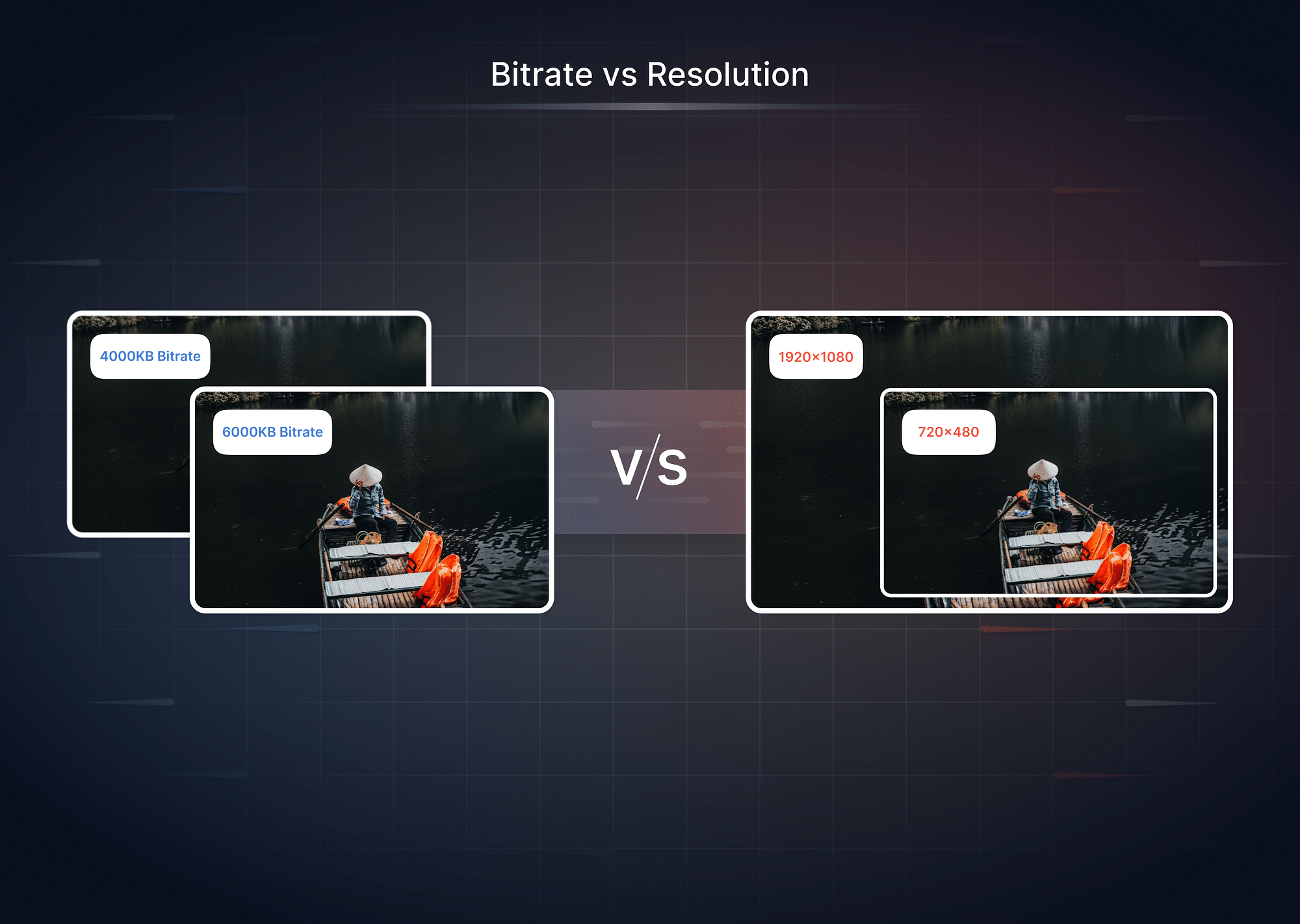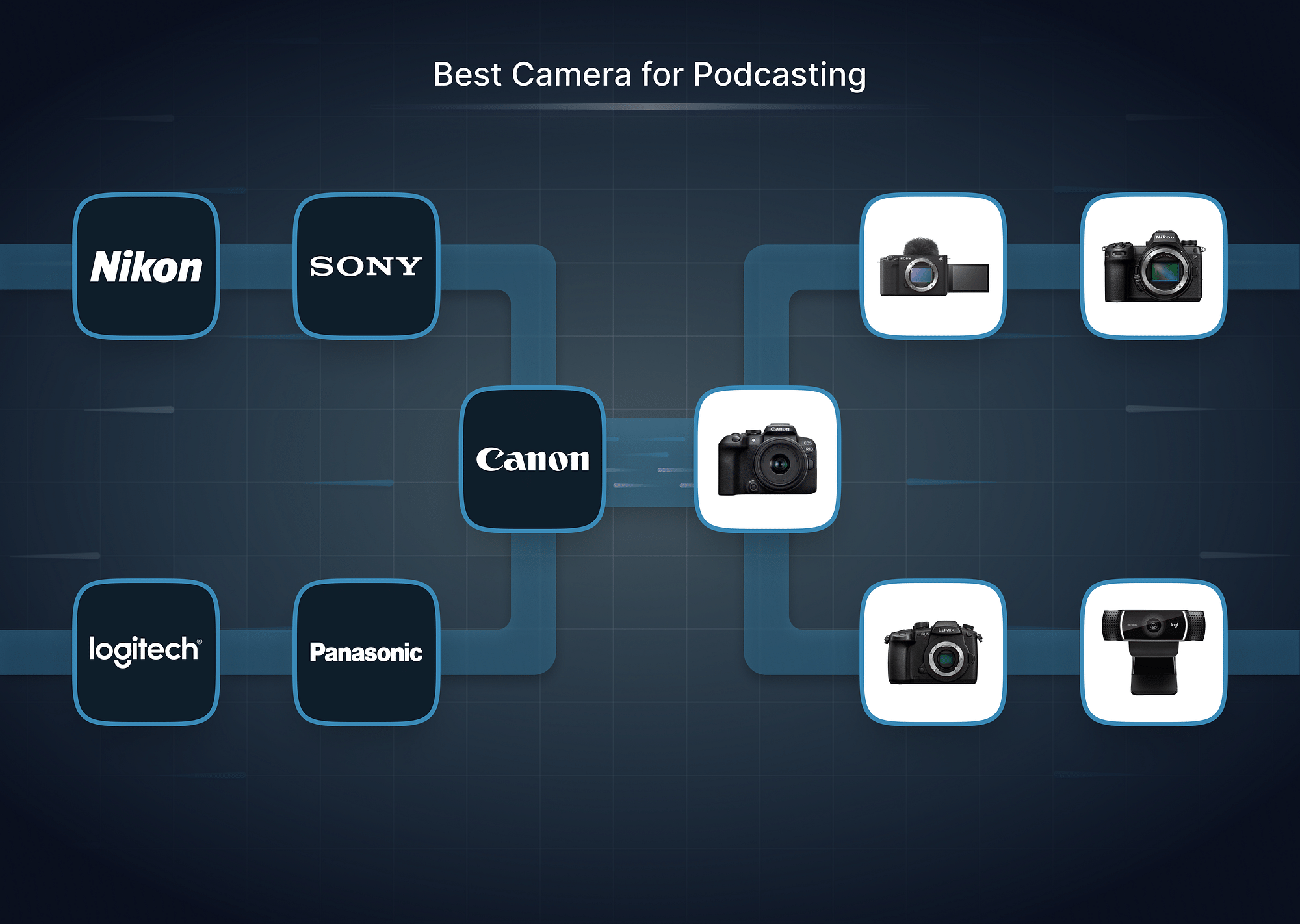Whether you're a content creator, gamer, or just someone interested in streaming, learning about the impact of bitrate and resolution can help you optimize video settings for a seamless experience. Let's find out what is the difference between them.
What is Video Bitrate?
Video bitrate refers to the amount of data transferred or processed per second during video playback or streaming. It is a critical factor that directly affects the quality and clarity of a video. Bitrate is typically measured in kilobits per second (kbps) or megabits per second (Mbps). Higher bitrates allow for more data per second, resulting in sharper details and smoother playback, while lower bitrates can cause visible compression artifacts like pixelation or blurring.
For instance, a video with a bitrate of 10 Mbps will generally look much sharper and retain more detail than a video with a bitrate of 2 Mbps, assuming the same resolution. However, higher bitrates demand more bandwidth, making them unsuitable for low-speed internet connections or bandwidth-restricted environments.
There are two primary types of video bitrate encoding:
- CBR (Constant Bitrate): Constant Bitrate encoding maintains the same bitrate throughout the entire video, regardless of the content’s complexity. This makes it predictable for bandwidth usage, which is ideal for live streaming or platforms where consistent delivery is necessary. However, CBR may compromise quality in scenes with high motion or complexity, as the fixed bitrate may not provide enough data to maintain detail.
- VBR (Variable Bitrate): Variable Bitrate encoding dynamically adjusts the bitrate based on the complexity of each frame. For example, a high-motion scene will have a higher bitrate than a static scene, ensuring better visual quality while minimizing file size. While VBR is more efficient and provides better quality, it requires more processing power and may introduce delays in encoding, making it less suitable for live streaming.
What is a Good Bitrate for Streaming?
Platforms like YouTube and Twitch provide specific guidelines for optimal stream settings tailored to their services, so reviewing those is a great starting point.
- For most streamers, Full HD (1080p) streaming typically requires a bitrate between 3500 and 6000 kbps, depending on your frame rate and content type. If you’re new to streaming or using entry-level equipment, starting with 720p at 30 fps is a more forgiving option, with recommended bitrates between 2500 and 4000 kbps.
- Always prioritize stable and uninterrupted playback over resolution. Viewers are more likely to abandon streams with buffering or lag than ones in lower resolution. Begin with settings that your hardware and bandwidth can handle comfortably, like a 720p, 30 fps stream, and gradually scale up as you upgrade your setup and connection.
What is Video Resolution?
Video resolution refers to the total number of pixels that make up each video frame, defining the video's sharpness and clarity. It is typically expressed as width x height, such as 1920 x 1080 for Full HD. Each resolution level—such as 480p (SD), 720p (HD), 1080p (Full HD), 4K (Ultra HD), or 8K—determines the visual quality of the video. Higher resolutions deliver sharper, more detailed images because they contain more pixels, but they also demand higher bitrates and processing power to maintain quality without introducing compression artifacts.
For example:
- 480p (SD) is sufficient for low-bandwidth environments or older devices but may appear blurry on modern displays.
- 1080p (Full HD) strikes a balance between clarity and data requirements, making it the standard for most content.
- 4K and 8K offer exceptional detail, ideal for professional production and large-screen viewing, but they require robust hardware and internet speeds.
- Resolution is crucial for setting the baseline of video quality, but its effectiveness depends on other factors like bitrate and frame rate, which influence the overall viewing experience.
Frame Rate vs. Resolution
Frame rate and resolution are two pillars of video quality, but they serve distinct purposes. While resolution determines the number of pixels in each frame (and thus the visual detail), frame rate refers to how many frames are displayed per second (fps), influencing the smoothness of motion.
- Impact:
- Frame rate affects how smooth the motion appears. Higher frame rates (e.g., 60 fps) create fluid motion, essential for fast-action content like sports or gaming.
- Resolution impacts the visual sharpness. Higher resolutions provide more detail but do not directly affect motion.
- Application:
- High frame rates are best for dynamic scenes where motion clarity is key, such as in gaming, live sports, or action-packed sequences.
- High resolution excels in static or detailed visuals, like nature documentaries or scenes with intricate textures.
Video Resolution Chart
Here's the table for the Video Resolution Chart:
| Resolution | Name | Aspect Ratio | Pixel Size |
|---|---|---|---|
| SD (Standard Definition) | 480p | 4:3 | 640 x 480 |
| HD (High Definition) | 720p | 16:9 | 1280 x 720 |
| Full HD (FHD) | 1080p | 16:9 | 1920 x 1080 |
| 2K (Quad HD) | 1440p | 16:9 | 2560 x 1440 |
| 4K (Ultra HD) | 2160p | 1:1.9 | 3840 x 2160 |
| 8K (Full Ultra HD) | 4320p | 16:9 | 7680 x 4320 |
- SD (480p): Standard Definition (SD) videos have a 4:3 aspect ratio and 640 x 480 pixel dimensions. They are commonly used for older formats or low-bandwidth scenarios.
- HD (720p): High Definition (HD) videos offer a 16:9 aspect ratio with 1280 x 720 pixels, providing better clarity and a more modern viewing experience compared to SD.
- Full HD (1080p): Full HD, with 1920 x 1080 pixels and a 16:9 aspect ratio, is the standard for most streaming services and provides excellent visual clarity.
- 2K (1440p): Quad HD (2K) doubles the pixel density of 1080p, with a resolution of 2560 x 1440, offering superior quality for gamers and video editors.
- 4K (2160p): Ultra HD, or 4K, with 3840 x 2160 pixels, delivers exceptional sharpness and is ideal for professional video production and premium streaming platforms.
- 8K (4320p): Full Ultra HD (8K) boasts 7680 x 4320 pixels and is the pinnacle of resolution, delivering hyper-realistic visuals for large displays and cinematic experiences.
Bitrate vs Resolution: Key Differences
| Aspect | Bitrate | Resolution |
|---|---|---|
| Measurement Units | kbps or Mbps | Pixels (e.g., 1920 x 1080) |
| Impact on Quality | Affects clarity and detail | Affects sharpness and size |
| Impact on File Size | Directly proportional | Indirectly proportional |
| Bandwidth Requirements | Higher bitrate = more bandwidth | Higher resolution requires higher bitrate |
| Relationship | Supports resolution quality | Defines pixel count |
- Measurement Units: Bitrate is expressed in terms of the data transfer rate, such as kilobits per second (kbps) or megabits per second (Mbps). This indicates how much data is transmitted every second. On the other hand, resolution is defined in terms of pixel dimensions, which describe the width and height of the video frame, such as 1920 x 1080 for Full HD.
- Impact on Quality: Bitrate is directly responsible for the level of detail and clarity in a video. A higher bitrate allows more data to be rendered, reducing compression artifacts and improving visual quality. Resolution, however, establishes the base quality by determining the total number of pixels in the video. For instance, a 4K video will inherently look sharper than a 1080p video, provided the bitrate is sufficient to support the higher resolution.
- Impact on File Size: File size is directly proportional to bitrate. For instance, a video encoded at a higher bitrate will take up more storage space because it contains more data per second. Resolution indirectly affects file size because higher resolution often necessitates higher bitrate for adequate quality. However, a high-resolution video with low bitrate will still have a smaller file size but poor quality.
- Bandwidth Requirements: Streaming at a higher bitrate consumes more internet bandwidth. For example, streaming 1080p video at 6 Mbps requires a stable and fast internet connection to avoid buffering. Resolution indirectly impacts bandwidth because higher resolutions like 4K and 8K require higher bitrates, and thus, faster internet speeds, for seamless playback.
- Relationship: The relationship between bitrate and resolution is crucial for achieving optimal video quality. For example, a low bitrate cannot do justice to a high-resolution video, leading to pixelation and poor clarity. Similarly, a high bitrate for a low-resolution video doesn’t improve quality but unnecessarily increases file size and bandwidth usage. Proper alignment ensures a balance between clarity, file size, and streaming performance.
Recommended Bitrates for Different Resolutions
| Video Dimension | Video Resolution | Video's Frame Rate (fps) | H264 Compatible | Audio Bitrate | Avg Video Bitrate | Avg Size for 1 GB Video |
|---|---|---|---|---|---|---|
| 3840x2160 | 4K | 30 | Yes | 128 kbps | 8,000-15,000 kbps | 700 MB |
| 2560x1440 | QHD | 30 | Yes | 128 kbps | 6,000-9,000 kbps | 500 MB |
| 1920x1080 | 1080p | 30 | Yes | 128 kbps | 4,000-6,000 kbps | 400 MB |
| 1280x720 | 720p | 30 | Yes | 128 kbps | 2,500-4,000 kbps | 300 MB |
| 640x480 | 480p | 30 | Yes | 128 kbps | 1,000-2,500 kbps | 210 MB |
| 426x240 | 240p | 30 | Yes | 128 kbps | 500-1,000 kbps | 140 MB |
When determining the appropriate bitrate for different video resolutions, it’s essential to align bitrate with resolution and frame rate for optimal quality and performance. Here’s a breakdown:
- 4K (3840x2160): For Ultra HD video, a bitrate between 8,000 kbps and 15,000 kbps is recommended, ensuring detailed visuals. This resolution typically consumes around 700 MB per minute for high-quality files.
- QHD (2560x1440): Quad HD content is best encoded at 6,000 kbps to 9,000 kbps, offering a balanced quality-to-bandwidth ratio. File sizes average about 500 MB per minute.
- 1080p (1920x1080): Full HD videos require 4,000 kbps to 6,000 kbps for smooth playback, suitable for most streaming platforms. On average, 1 GB of data allows about 400 MB per minute of video storage.
- 720p (1280x720): For High Definition (HD) streaming, bitrates between 2,500 kbps and 4,000 kbps suffice, ideal for live streaming with moderate bandwidth. This results in file sizes of approximately 300 MB per minute.
- 480p (640x480): Standard Definition (SD) videos need 1,000 kbps to 2,500 kbps, making them efficient for low-bandwidth conditions. File sizes are about 210 MB per minute.
- 240p (426x240): Low-resolution videos require bitrates as low as 500 kbps to 1,000 kbps, suitable for minimal bandwidth usage. These videos take up around 140 MB per minute.
Aligning bitrate with resolution ensures smooth streaming experiences and maintains video quality without overburdening file sizes or internet bandwidth. Let me know if you’d like to expand further!
Conclusion
Balancing bitrate vs resolution is essential for achieving the best video quality while considering bandwidth and file size limitations. Understanding how these factors interact ensures optimal performance, whether you’re live streaming or producing high-quality video content.
FAQs
- What does low bitrate mean?
Low bitrate results in reduced video quality, characterized by pixelation or blurriness, especially in high-motion scenes.
- How can I choose the right bitrate and resolution?
Consider your internet speed, content type, and audience. Match resolution and bitrate recommendations for the best results.
- Can a high bitrate improve a low resolution video?
No, high bitrate cannot add detail to a low-resolution video but can reduce compression artifacts.
- How does frame rate affect bitrate?
Higher frame rates require higher bitrates to maintain smooth playback and avoid motion artifacts.
- What tools can I use to adjust bitrate and resolution?
Tools like OBS Studio, Adobe Premiere Pro, and HandBrake allow you to configure bitrate and resolution settings for video optimization.




